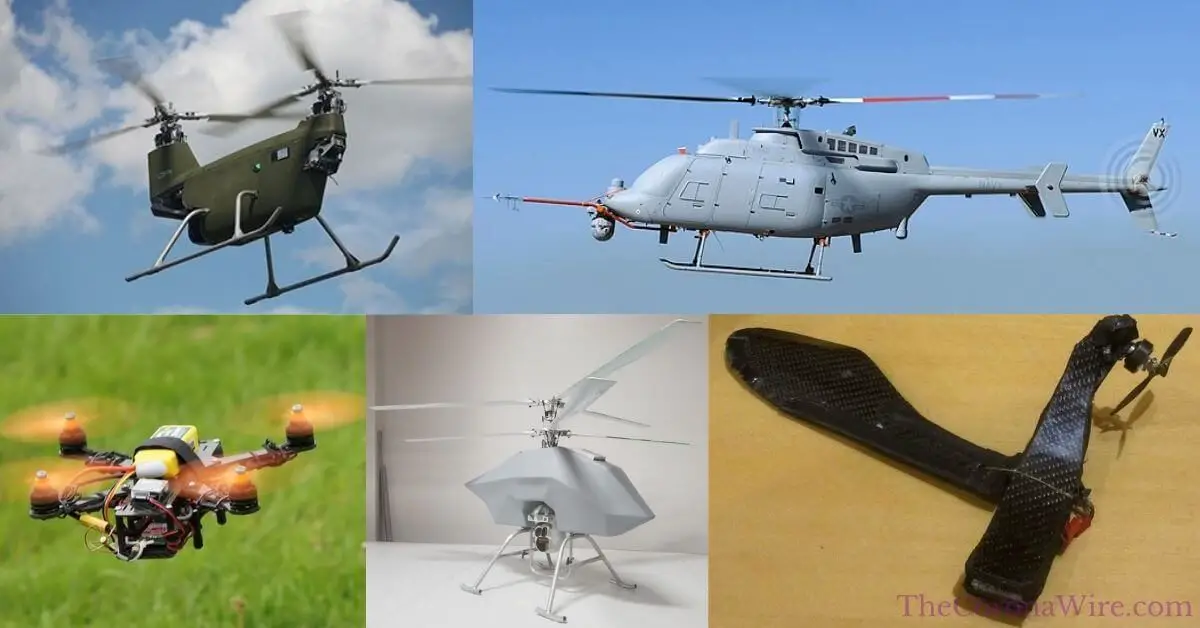There are several types of rotary-wing unmanned aerial vehicles (UAVs) sold on the market. Most of these types branch off further into additional sub-types which we will be going into below.
These types of UAVs are also commonly referred to as unmanned helicopters or helicopter drones/UAVs.
Here are the 4 main types of rotary-wing UAVs:
- Monocopters
- Single-rotor UAVs
- Twin-rotor UAVs
- Multi-rotor UAVs
Take note that hybrid fixed-wing/VTOL UAVs will be excluded from this article. Additionally, unmanned gyrocopters and unmanned gyrodynes will also be excluded as they are technically hybrids.
A Quick Overview On What Rotary-Wing Drones/UAVs Are And How They Work
Rotary-wing UAVs are unmanned robotic aircraft that generate lift using their lifting surfaces (in this case rotors/props/blades) along with their powerplant.
Rotary-wing UAVs use rotors that act as small airfoils which rotate to capture airflow forcing air downwards creating a pressure difference that creates a suction effect thus generating lift. The direction the UAV can travel is changed by altering the angle of the frame and/or props.
Check out our full post on what rotary-wing drones/UAVs are where we dive into how they work, applications, parts/components, advantages/disadvantages, common powerplants and examples:
Related Post: What Are Rotary-Wing UAVs? Unmanned Rotorcraft Explained
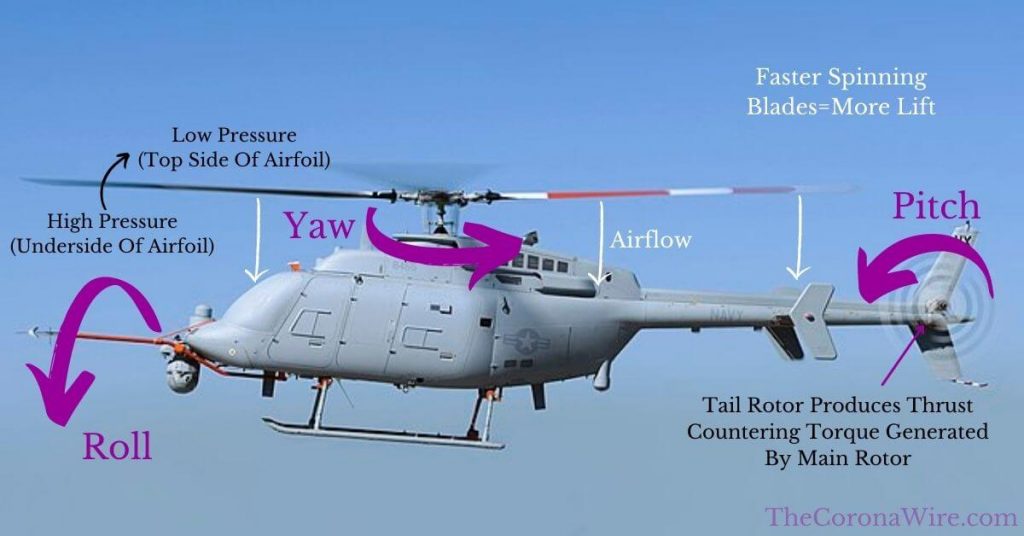
The rotors are sized and shaped in a way that captures the flow of air as the speed the prop rotates increases thus producing lift.
Air flows faster on the curved top side of the blade than on the flatter underside due to its shape. This causes less air pressure to accumulate on the top of the prop creating a suction that lifts the prop up enabling both unmanned fixed-wing and rotary-wing drones to fly.
These types of drones actually use the same principle as fixed-wing UAVs in the way they generate lift. These rotors are used as airfoils just like the wings of a fixed-wing aircraft.
Single-rotor UAVs and twin-rotor UAVs both use large main rotors (single with one rotor and twin with two) that can be configured differently. These main rotors are attached to and controlled by a swashplate mechanism.
Multi-rotor UAVs use a combination of three or more props that are typically much smaller than the main rotors from a single or twin-rotor UAV.
Some props may rotate clockwise and the opposing props may rotate anti-clockwise to cancel torque generated by each rotor which is why they don’t need a tail rotor. This is also often the case for twin & multi-rotor UAVs that have contra-rotating main rotors to cancel the torque they generate.
These drones obtain energy to produce thrust from powerplants such as engines, batteries, fuel cells, powered drone tethers among others.
They also incorporate other devices such as propellers that are powered by electric motors.
Check out our full post on drone propellers including the different types, how they work, their different sizes and pitch, their materials, how to choose them and much more.
Related Post: Drone Propellers Explained: Detailed Beginner’s Guide To Drone Anatomy
What Are Monocopters?
Monocopters, also called unmanned gyropters, are unmanned aerial vehicles (UAVs) with a single rotor that generate lift by rotating their entire frame and do not have an anti-torque device.
These types of unmanned rotorcraft are very uncommon but are built as DIY projects by enthusiasts. There has never been a manned monocopter as it would not be the most pleasant experience for a person.
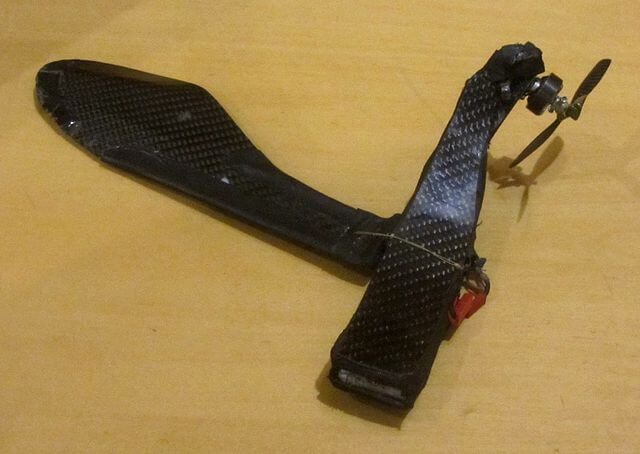
These types of rotorcraft don’t need anti-torque devices but are typically difficult to control.
Check out our full post on rotary-wing advantages and disadvantages where we explain several benefits and drawbacks to these UAVs:
Related Post: 11 Rotary-Wing Drone/UAV Advantages+Disadvantages Explained
The Nano made by RoboSeed (seen in the image above) and the Samarai Flyer made by Lockheed Martin are two examples of monocopters.
What Are Single-Rotor Unmanned Aerial Vehicles (UAVs)?
Single-rotor unmanned aerial vehicles (UAVs), often called unicopters, are drones with one main spinning rotor along with an anti-torque device (often a tail rotor) that produces lift and aids in controlling the UAV in flight.
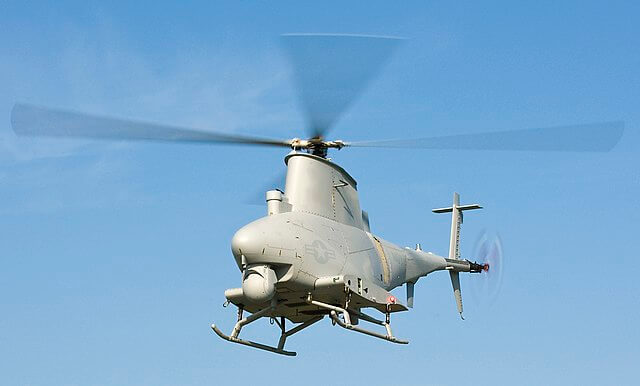
The types of single-rotor UAVs can be further broken up according to the control systems they use.
Some use a multi-bladed tail rotor, some use a ducted fan/fenestron, and some don’t have an anti-torque device at all (NOTAR/no tail rotor).
These types of UAVs are actually more efficient than other types of unmanned helicopters such as multi-rotor UAVs but are far less stable.
Check out our full article where we dive into what single-rotor UAVs are along with how they work, the types, differences between all rotorcraft, applications, benefits/drawbacks and examples:
Related Post: What Are Single-Rotor Drones? Unmanned Helicopters Explained
The MQ-8B Fire Scout made by Northrop Grumman and the Vapor 55 made by AeroVironment (Pulse Aerospace) are two examples of single-rotor UAVs.
What Are Twin-Rotor Unmanned Aerial Vehicles (UAVs)?
Twin-rotor unmanned aerial vehicles (UAVs), often called bicopters, are drones with two large main contra-rotating rotors that produce lift and aid in controlling the UAV in flight.
These types of UAVs do not need an anti-torque device as the two rotors cancel the torque each generates by rotating in opposite directions (contra-rotating).
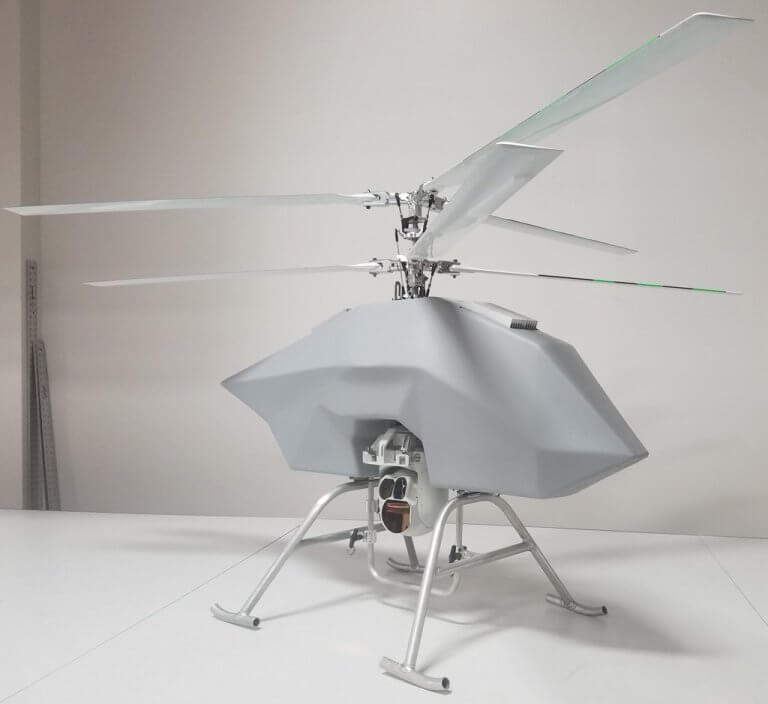
The types of twin-rotor UAVs include tandem rotor UAVs, transverse rotor UAVs, intermeshing rotor UAVs and coaxial rotor UAVs.
These types of rotary-wing UAVs typically don’t require anti-torque devices as they use contra-rotating rotors to cancel torque generated by these main props but are far more complex and therefore more prone to serious malfunctions and high maintenance costs.
The Bolt made by Drone Aviation Corp. (seen in the image above) and the HT-100 made by Anavia (intermeshing rotor) are two examples of twin-rotor UAVs.
What Are Multi-Rotor Unmanned Aerial Vehicles (UAVs)?
Multi-rotor unmanned aerial vehicles (UAVs), often called multicopters, are drones that use three or more contra-rotating fixed pitch rotors that produce lift and aid in controlling the UAV in flight.
These types of UAVs do not need an anti-torque device either as each blade is spun in different directions depending on the number of rotors on the drone which cancels the torque each prop generates.
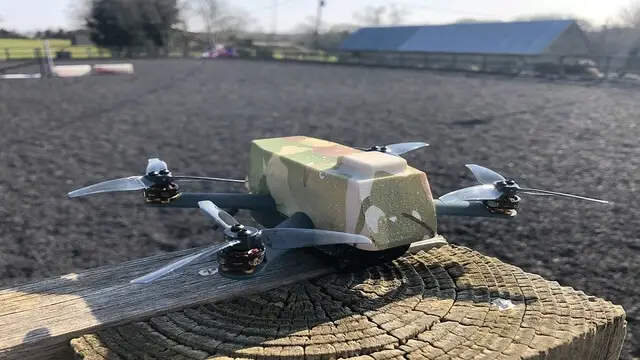
The types of multi-rotor UAVs include tricopters (3 rotors), quadcopters (4 rotors), hexacopters (6 rotors), and octocopters (8 rotors).
Multi-rotor UAVs are known to be stable but are not efficient as they have several small rotors that consume a lot of energy while producing a limited amount of lift.
Check out our full article on rotary-wing parts/components where we dive into what each is, how they work and the different sub-types of each component (if any):
Related Post: Main Rotary-Wing Drone/UAV Parts & Components Explained
The BUG made by BAE Systems (seen in the image above) and the DS30 made by Doosan Mobility Innovation (octocopter) are two examples of multi-rotor UAVs.
Conclusion
The types of rotary-wing UAVs have not all yet been as successful as others but they definitely all have potential due to the benefits they can provide.
We highly recommend you check out our main article on what rotary-wing UAVs are to learn more about these types of drones.
